Investigating the Effects of Environmental Regulation on Industrial Ecological Efficiency in China Using a Panel Smooth Transition Regression Model
Abstract
:1. Introduction
2. Literature Review
3. Methods and Data
3.1. Methods
3.1.1. Superefficiency SBM Model Incorporating Undesirable Outputs
3.1.2. The Panel Smooth Transition Regression Model
3.2. Variable Selection
3.2.1. Explained Variable
3.2.2. Explanatory Variable
3.2.3. Transition Variable
3.2.4. Control Variables
3.3. Data Sources
4. Results and Discussion
4.1. Industrial Ecological Efficiency
4.2. Results of PSTR Models
4.2.1. The Panel Unit Root Test
4.2.2. Linearity Test
4.2.3. Remaining Nonlinearity Test
4.2.4. PSTR Estimation Results
5. Conclusions and Policy Suggestions
Author Contributions
Funding
Institutional Review Board Statement
Informed Consent Statement
Data Availability Statement
Conflicts of Interest
References
- National Bureau of Statistics of China. National Data. 2021. Available online: http://data.stats.gov.cn/english/adv.htm?m=advquery&cn=E0103 (accessed on 10 May 2020).
- Matsumoto, K.; Chen, Y.Y. Industrial eco-efficiency and its determinants in China: A two-stage approach. Ecol. Indic. 2021, 130, 108072. [Google Scholar] [CrossRef]
- Liu, F.; Zhou, S.; Yang, Y.; Liu, C. Research on industrial ecological efficiency evaluation and improvement countermeasures based on data-driven evaluations from 30 provinces and cities in China. Sustainability 2022, 14, 8665. [Google Scholar] [CrossRef]
- Oggioni, G.; Riccardi, R.; Toninelli, R. Eco-efficiency of the world cement industry: A data envelopment analysis. Energy Policy 2011, 39, 2842–2854. [Google Scholar] [CrossRef]
- Ezici, B.; Eğilmez, G.; Gedik, R. Assessing the eco-efficiency of US manufacturing industries with a focus on renewable vs. non-renewable energy use: An integrated time series MRIO and DEA approach. J. Clean. Prod. 2020, 253, 119630. [Google Scholar] [CrossRef]
- Huang, J.; Xia, J.; Yu, Y.; Zhang, N. Composite eco-efficiency indicators for China based on data envelopment analysis. Ecol. Indic. 2018, 85, 674–697. [Google Scholar] [CrossRef]
- Van Caneghem, J.; Block, C.; Van Hooste, H.; Vandecasteele, C. Eco-efficiency trends of the Flemish industry: Decoupling of environmental impact from economic growth. J. Clean. Prod. 2010, 18, 1349–1357. [Google Scholar] [CrossRef]
- Dahlström, K.; Ekins, P. Eco-efficiency trends in the UK steel and aluminum industries. J. Ind. Ecol. 2005, 9, 171–188. [Google Scholar] [CrossRef]
- Xavier Belem, M.J.; Vieira Junior, M.; Mummolo, G.; Facchini, F. An ahp-based procedure for model selection for eco-efficiency assessment. Sustainability 2021, 13, 12121. [Google Scholar] [CrossRef]
- Park, Y.S.; Egilmez, G.; Kucukvar, M. A novel life cycle-based principal component analysis framework for eco-efficiency analysis: Case of the United States manufacturing and transportation nexus. J. Clean. Prod. 2015, 92, 327–342. [Google Scholar] [CrossRef]
- Richa, K.; Babbitt, C.W.; Gaustad, G. Eco-efficiency analysis of a lithium-ion battery waste hierarchy inspired by circular economy. J. Ind. Ecol. 2017, 21, 715–730. [Google Scholar] [CrossRef]
- Mendoza, J.M.F.; D’aponte, F.; Gualtieri, D.; Azapagic, A. Disposable baby diapers: Life cycle costs, eco-efficiency and circular economy. J. Clean. Prod. 2019, 211, 455–467. [Google Scholar] [CrossRef]
- Wang, W.; Jiang, D.; Chen, D.; Chen, Z.; Zhou, W.; Zhu, B. A Material Flow Analysis (MFA)-based potential analysis of eco-efficiency indicators of China’s cement and cement-based materials industry. J. Clean. Prod. 2016, 112, 787–796. [Google Scholar] [CrossRef]
- Chen, X.; Wang, K.; Wan, G.; Liu, Y.; Liu, W.; Shen, W.; Shi, J. Evaluation and empirical research on eco-efficiency of financial industry based on carbon footprint in China. Sustainability 2022, 14, 13677. [Google Scholar] [CrossRef]
- Tsionas, M.G.; Tzeremes, N.G. Eco-efficiency estimation with quantile stochastic frontiers: Evidence from the United States. J. Environ. Manag. 2022, 320, 115876. [Google Scholar] [CrossRef] [PubMed]
- Ren, S.G.; Zhang, R.B.; Yuan, B.L. Industrial eco-efficiency evaluation and regional differences of Yangtze River economic belt. Acta Ecol. Sin. 2018, 38, 5485–5497. (In Chinese) [Google Scholar]
- Zhao, X.; Wang, Y.X.; Zhao, F.F. The spatiotemporal transition characteristics and spatial spillover effects of urban industrial ecological efficiency: Taking the Yangtze River Economic Belt as an example. Stat. Decis. 2022, 38, 133–138. (In Chinese) [Google Scholar]
- Wang, Y.; Liu, J.; Hansson, L.; Zhang, K.; Wang, R. Implementing stricter environmental regulation to enhance eco-efficiency and sustainability: A case study of Shandong Province’s pulp and paper industry, China. J. Clean. Prod. 2011, 19, 303–310. [Google Scholar] [CrossRef]
- Fan, Y.; Bai, B.; Qiao, Q.; Kang, P.; Zhang, Y.; Guo, J. Study on eco-efficiency of industrial parks in China based on data envelopment analysis. J. Environ. Manag. 2017, 192, 107–115. [Google Scholar] [CrossRef] [PubMed]
- Wang, D.; Wan, K.; Yang, J. Measurement and evolution of eco-efficiency of coal industry ecosystem in China. J. Clean. Prod. 2019, 209, 803–818. [Google Scholar] [CrossRef]
- Song, C.; Yin, G.; Lu, Z.; Chen, Y. Industrial ecological efficiency of cities in the Yellow River Basin in the background of China’s economic transformation: Spatial-temporal characteristics and influencing factors. Environ. Sci. Pollut. Res. 2022, 29, 4334–4349. [Google Scholar] [CrossRef]
- Stergiou, E.; Kounetas, K. Heterogeneity, spillovers and eco-efficiency of European industries under different pollutants’ scenarios. Is there a definite direction? Ecol. Econ. 2022, 195, 107377. [Google Scholar] [CrossRef]
- Liu, L.; Liu, M. How does the digital economy affect industrial eco-efficiency? Empirical evidence from China. Data Sci. Financ. Econ. 2022, 2, 371–390. [Google Scholar] [CrossRef]
- Li, B.; Hu, Z.; Miao, C.; Zhang, B.; Kang, W. Spatio-temporal evolution characteristics and influencing factors of the industrial eco-efficiency in the Yellow River Basin. Geogr. Res. 2021, 40, 2156–2169. (In Chinese) [Google Scholar]
- Zhang, X.L.; Qiu, F.D.; Tan, J.T.; Wang, C.J. Analysis of the characteristics of spatial and temporal differentiation of Chinese industrial ecological efficiency and its influencing factors. Sci. Geogr. Sin. 2020, 40, 335–343. (In Chinese) [Google Scholar]
- Guo, L.; Xu, S.Q. Industrial eco-efficiency with the integration super efficiency DEA: The central six provinces 2003–2013 data as an example. Econ. Geogr. 2016, 6, 116–121. (In Chinese) [Google Scholar]
- Xu, J.J.; Wang, H.J.; Tang, K. The sustainability of industrial structure on green eco-efficiency in the Yellow River Basin. Econ. Anal. Policy 2022, 74, 775–788. [Google Scholar] [CrossRef]
- Zhang, Q.F.; Tang, X.; Xiao, Y.; Xiang, X.; Huang, H. Coordination of industrial structure and eco-efficiency in ecologically fragile areas: A case study of the Loess Plateau, China. J. Environ. Manag. 2023, 331, 117237. [Google Scholar] [CrossRef] [PubMed]
- Wu, K.; You, K.; Ren, H.; Gan, L. The impact of industrial agglomeration on ecological efficiency: An empirical analysis based on 244 Chinese cities. Environ. Impact Assess. Rev. 2022, 96, 106841. [Google Scholar] [CrossRef]
- Chen, C.; Sun, Y.; Lan, Q.; Jiang, F. Impacts of industrial agglomeration on pollution and ecological efficiency-A spatial econometric analysis based on a big panel dataset of China’s 259 cities. J. Clean. Prod. 2020, 258, 120721. [Google Scholar] [CrossRef]
- He, J.; Hu, S. Ecological efficiency and its determining factors in an urban agglomeration in China: The Chengdu-Chongqing urban agglomeration. Urban Clim. 2022, 41, 101071. [Google Scholar] [CrossRef]
- Darnall, N.; Henriques, I.; Sadorsky, P. Do environmental management systems improve business performance in an international setting. J. Int. Manag. 2008, 14, 364–376. [Google Scholar] [CrossRef]
- Chakraborty, P.; Chatterjee, C. Does environmental regulation indirectly induce upstream innovation? New evidence from India. Res. Policy 2017, 46, 939–955. [Google Scholar] [CrossRef]
- Jiang, P.P.; Wang, Y.; Luo, J.; Zhu, L.; Shi, R.; Hu, S.; Zhu, X. Measuring static and dynamic industrial eco-efficiency in China based on the MinDS-Malmquist-Luenberger model. Environ. Dev. Sustain. 2023, 25, 5241–5261. [Google Scholar] [CrossRef]
- Puertas, R.; Guaita-Martinez, J.M.; Carracedo, P.; Ribeiro-Soriano, D. Analysis of European environmental policies: Improving decision making through eco-efficiency. Technol. Soc. 2022, 70, 102053. [Google Scholar] [CrossRef]
- Cui, S.; Wang, Y.; Zhu, Z.; Zhu, Z.; Yu, C. The impact of heterogeneous environmental regulation on the energy eco-efficiency of China’s energy-mineral cities. J. Clean. Prod. 2022, 350, 131553. [Google Scholar] [CrossRef]
- Ghisetti, C.; Rennings, K. Environmental innovations and profitability: How does it pay to be green? Soc. Sci. Electron. Publ. 2013, 75, 106–117. [Google Scholar] [CrossRef]
- Yuan, B.L.; Ren, S.G.; Chen, X.H. Can environmental regulation promote the coordinated development of economy and environment in China’s manufacturing industry?—A panel data analysis of 28 sub-sectors. J. Clean. Prod. 2017, 149, 11–24. [Google Scholar] [CrossRef]
- Xu, X.G.; Zhang, J.J. Impacts of environmental regulations on industrial eco-efficiency from the perspective of interaction between regulations. Soft Sci. 2019, 33, 67–71. (In Chinese) [Google Scholar]
- Deng, Z.B.; Li, L.P.; Wang, J.; Cao, Y.F. Regional differences and driving factors of China’s industrial ecological efficiency: Based on technology heterogeneity. Resour. Sci. 2022, 44, 1009–1021. [Google Scholar]
- Zhang, J.; Liu, Y.; Chang, Y.; Zhang, L. Industrial eco-efficiency in China: A provincial quantification using three-stage data envelopment analysis. J. Clean. Prod. 2017, 143, 238–249. [Google Scholar] [CrossRef]
- Yu, Y.; Huang, J.; Zhang, N. Industrial eco-efficiency, regional disparity, and spatial convergence of China’s regions. J. Clean. Prod. 2018, 204, 872–887. [Google Scholar] [CrossRef]
- Liu, L.; Zhao, Y.; Yang, Y.; Liu, S.; Gong, X.; Jiang, P. Study on the measurement of industrial eco-efficiency, spatial distribution and influencing factors in Yangtze River Economic Belt. PLoS ONE 2023, 18, e0283964. [Google Scholar] [CrossRef] [PubMed]
- Wang, X.; Wu, Q.; Majeed, S.; Sun, D. Fujian’s industrial eco-efficiency: Evaluation based on sbm and the empirical analysis of influencing factors. Sustainability 2018, 10, 3333. [Google Scholar] [CrossRef]
- Tone, K. A slacks-based measure of efficiency in data envelopment analysis. Eur. J. Oper. Res. 2001, 130, 498–509. [Google Scholar] [CrossRef]
- González, A.; Teräsvirta, T.; van Dijk, D. Panel Smooth Transition Regression Models; Research Paper Series 165; Quantitative Finance Research Centre, University of Technology: Sydney, Austrilia, 2005. [Google Scholar]

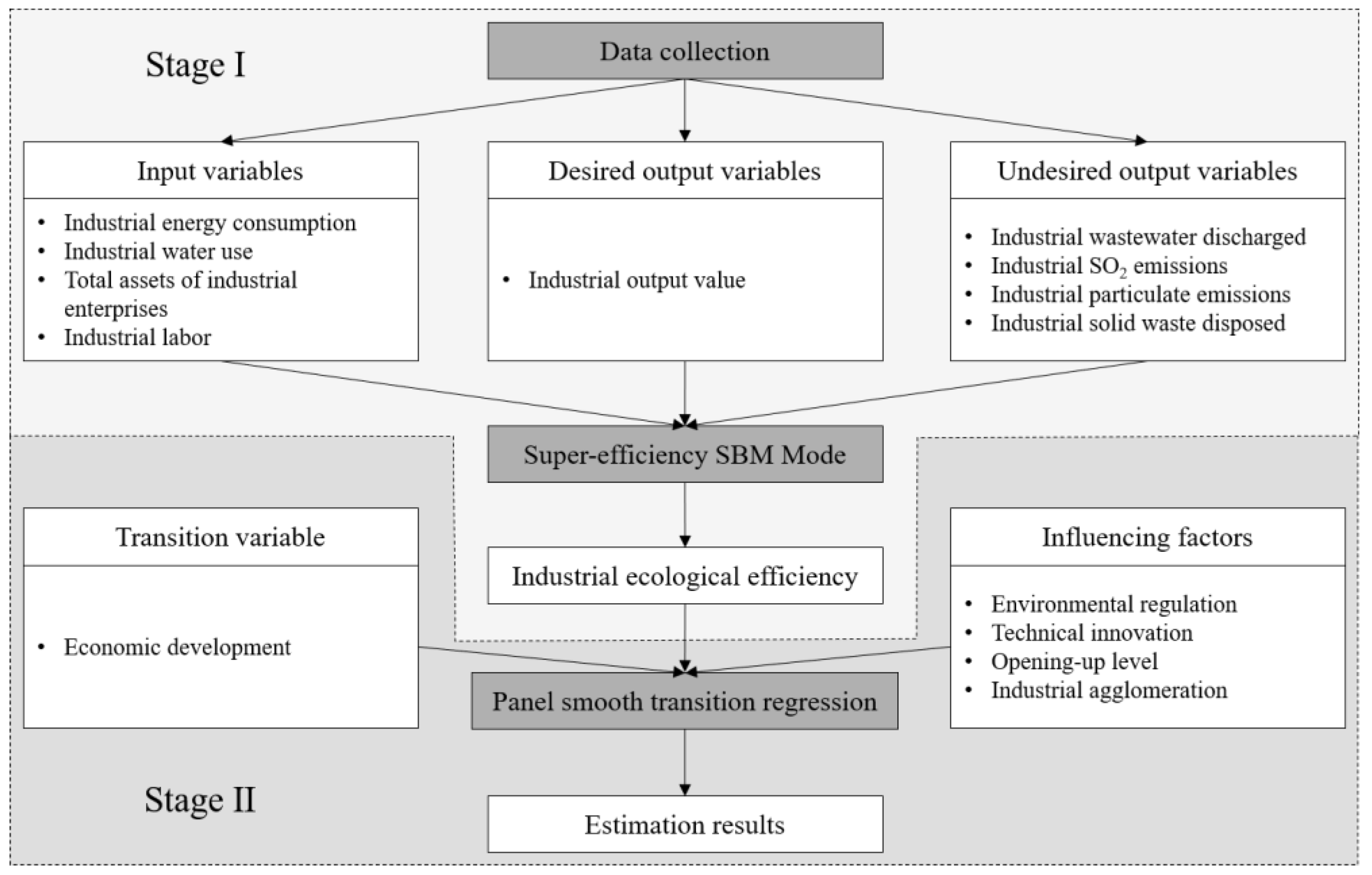
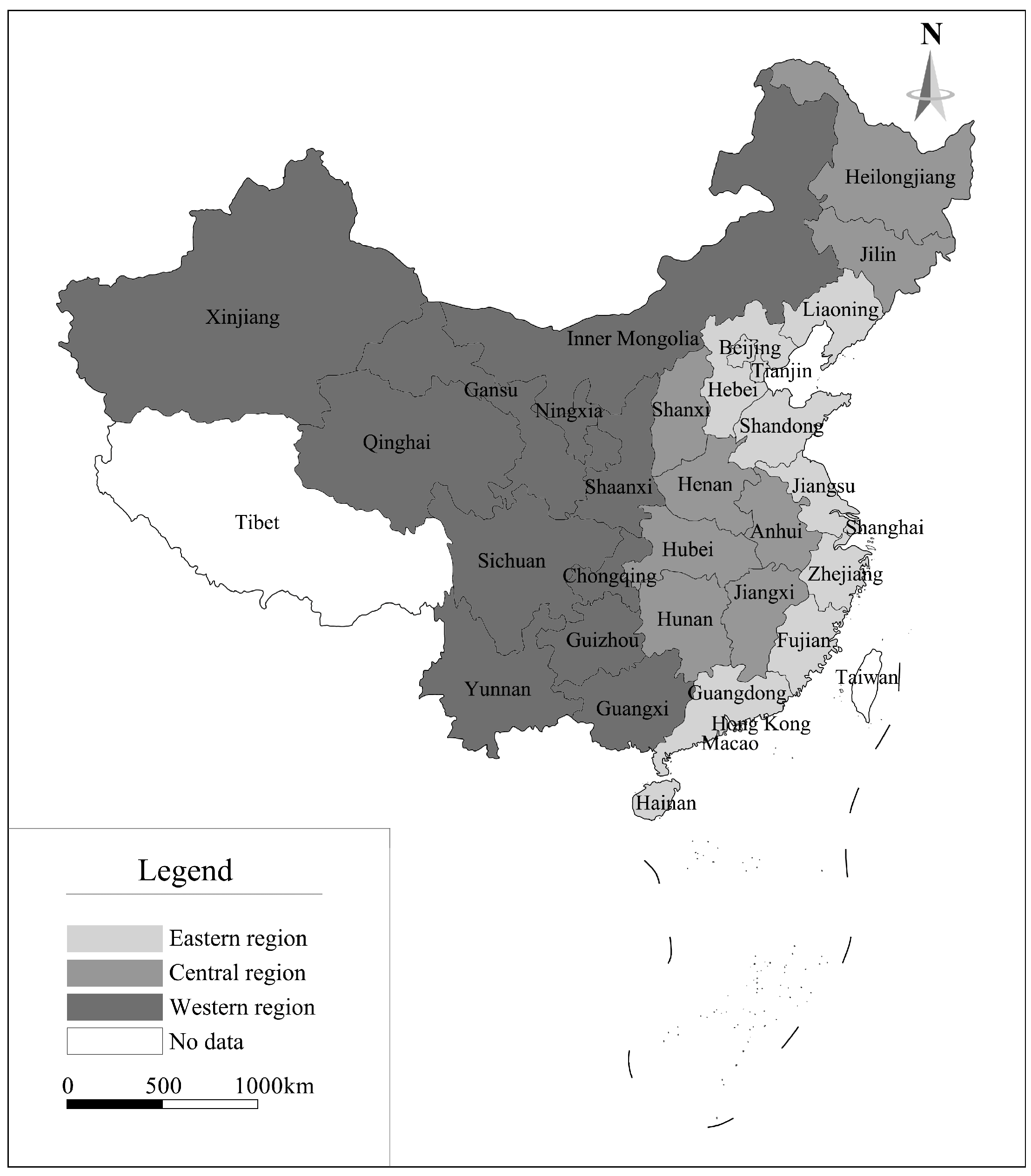
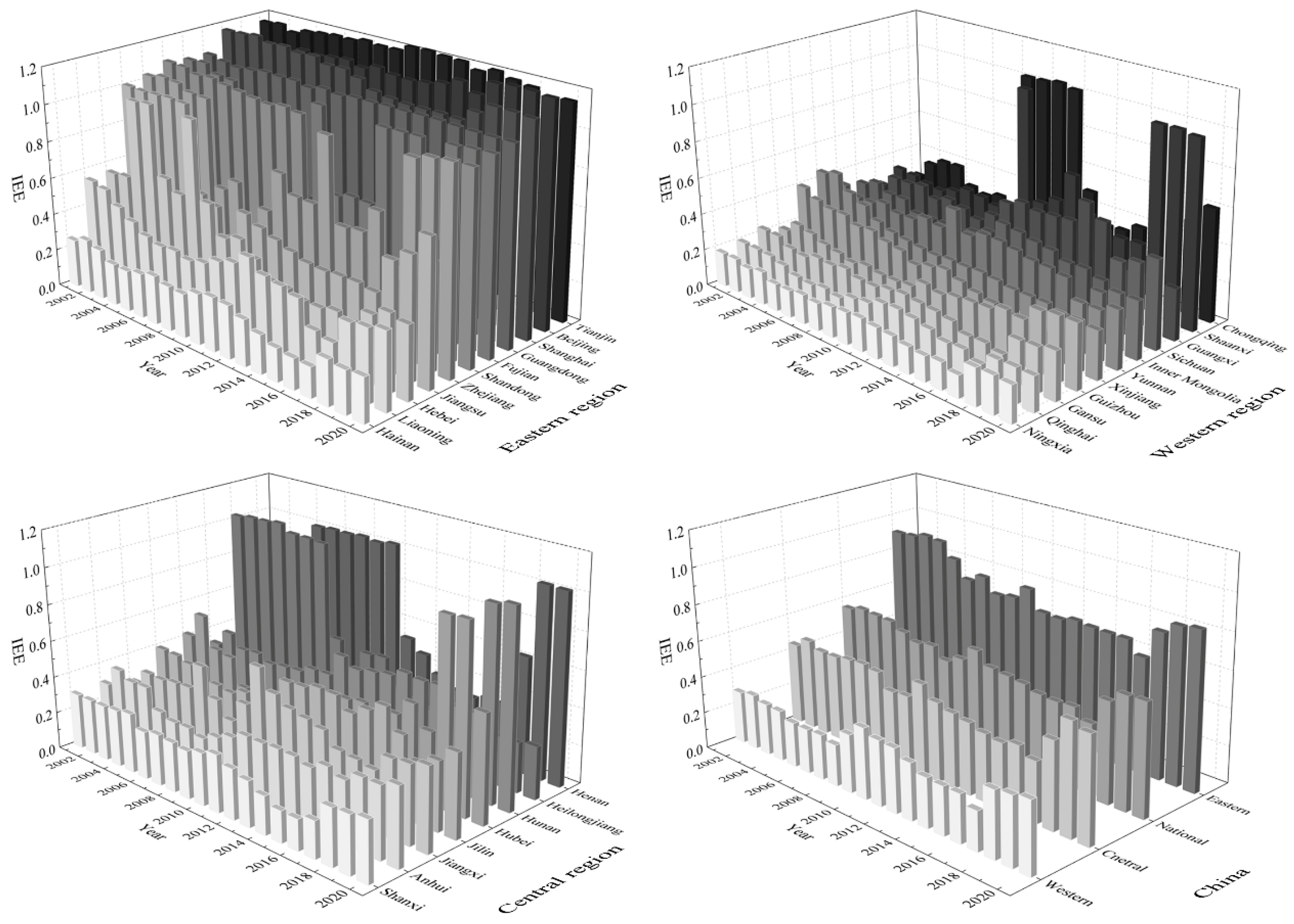
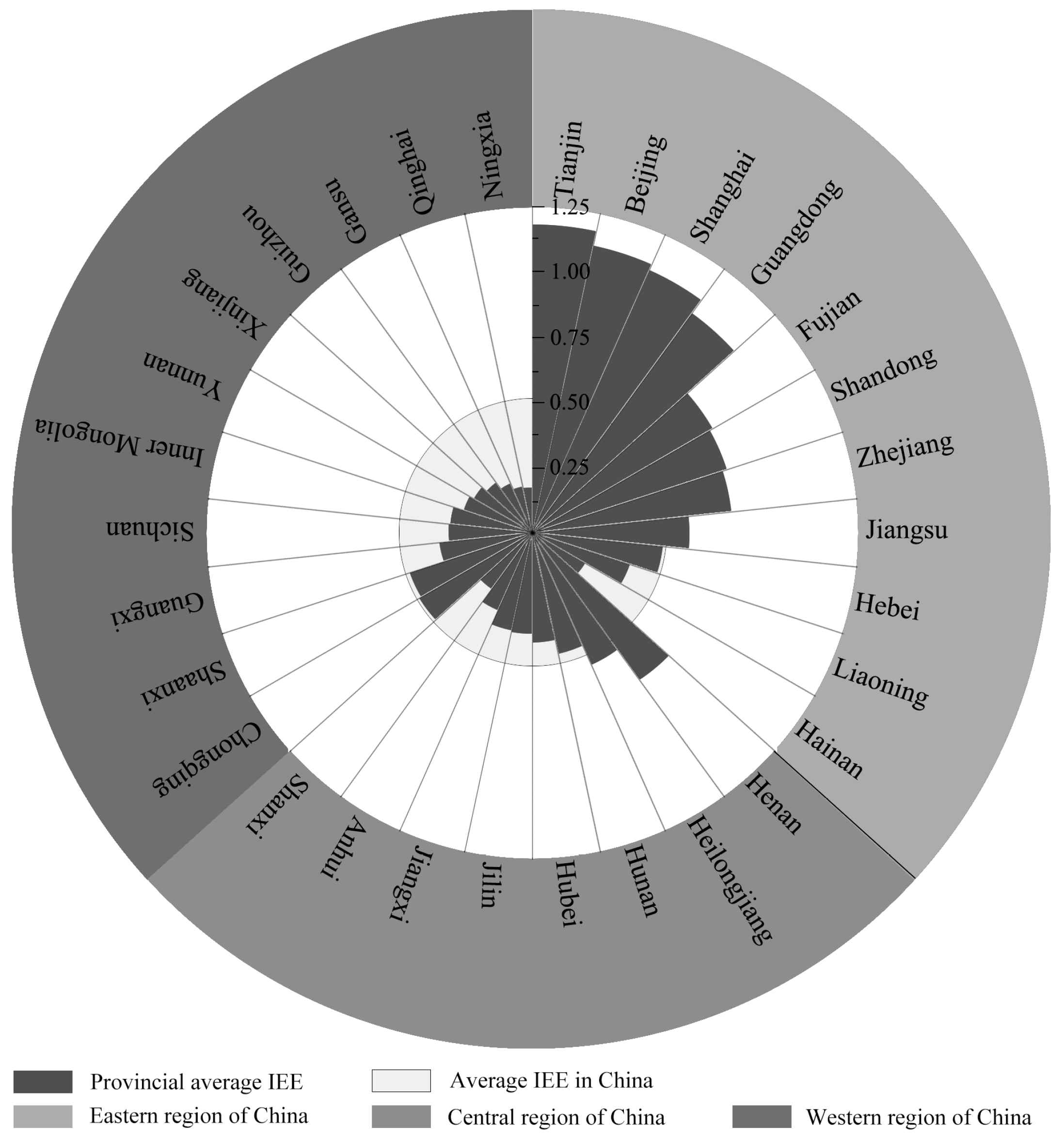
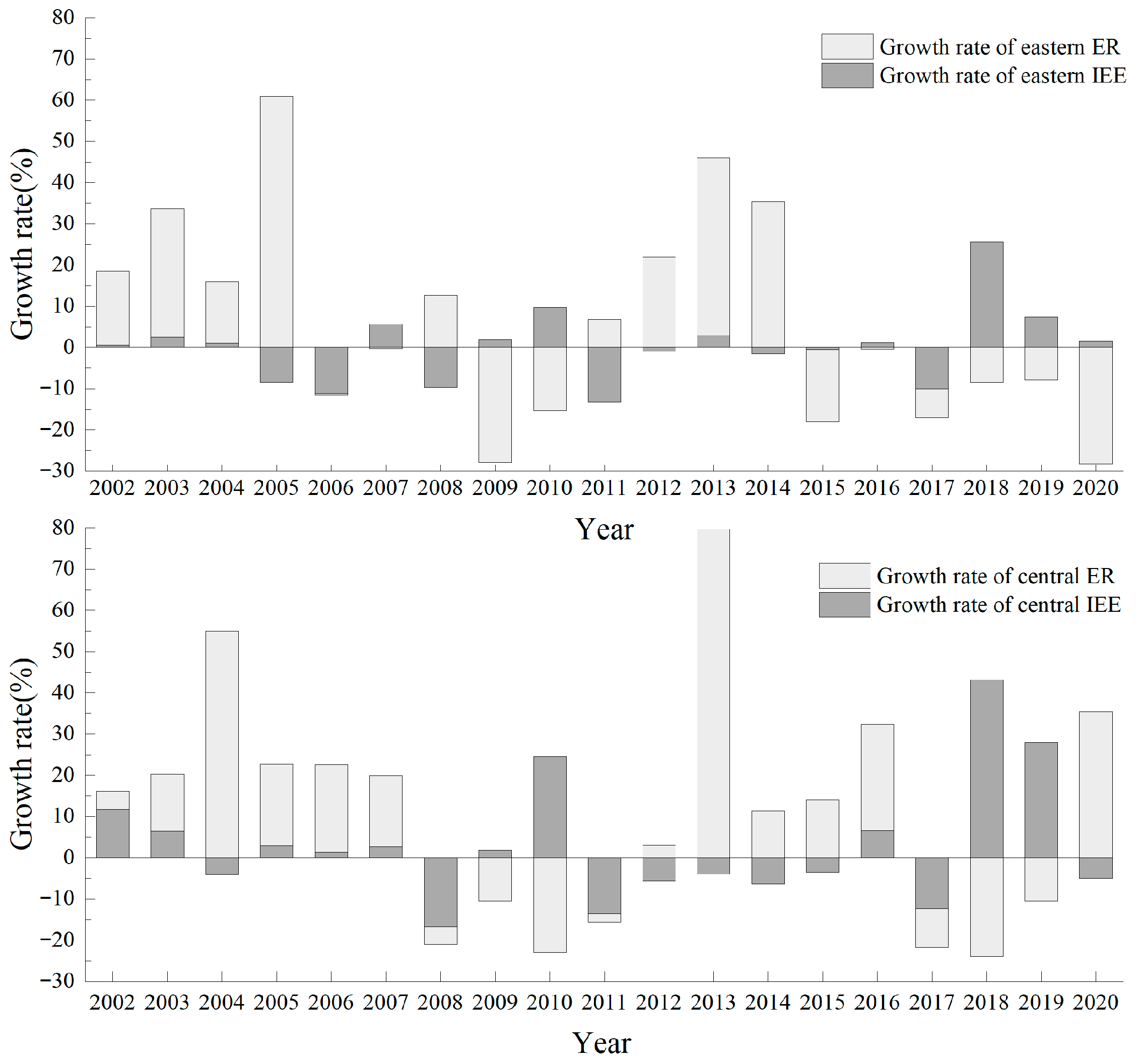
| Category | Quantitative Indicators | Unit |
|---|---|---|
| Input | Industrial energy consumption | Tons of standard coal equivalent |
| Industrial water use | Tons | |
| Total assets of industrial enterprises | Million CNY | |
| Industrial labor | Persons | |
| Desirable output | Industrial output value | Million CNY |
| Undesirable output | Industrial wastewater discharged | Tons |
| Industrial SO2 emissions | Tons | |
| Industrial particulate emissions (smoke and dust) | Tons | |
| Industrial solid waste disposed | Tons |
| Test | LLC | ADF-Fisher | ||
|---|---|---|---|---|
| Statistic | p-Value | Statistic | p-Value | |
| IEEit | −3.059 *** | 0.001 | −8.509 *** | 0.000 |
| Ln(ER)it | −2.512 *** | 0.006 | −9.491 *** | 0.000 |
| Ln(GDP)it | −2.798 *** | 0.006 | −10.866 *** | 0.000 |
| Ln(TI)it | −3.201 *** | 0.001 | −6.048 *** | 0.000 |
| Ln(OP)it | −3.407 *** | 0.001 | −7.764 *** | 0.000 |
| Ln(IA)it | −2.281 ** | 0.011 | −10.109 *** | 0.000 |
| Tests | Eastern Region | Central Region | Western Region | |||
|---|---|---|---|---|---|---|
| Statistic | p-Value | Statistic | p-Value | Statistic | p-Value | |
| H0: Linear Model vs. H1: PSTR Model with at Least One Threshold Variable (r = 1) | ||||||
| Lagrange multiplier—Wald (LMW) | 38.651 *** | 0.000 | 32.256 *** | 0.000 | 18.546 *** | 0.000 |
| Lagrange multiplier—Fischer (LMF) | 8.221 *** | 0.000 | 7.112 *** | 0.000 | 4.118 *** | 0.000 |
| Likelihood ratio Wald (LR) | 41.954 *** | 0.000 | 36.009 *** | 0.000 | 18.965 *** | 0.000 |
| Tests | Eastern Region | Central Region | Western Region | |||
|---|---|---|---|---|---|---|
| Statistic | p-Value | Statistic | p-Value | Statistic | p-Value | |
| H0: PSTR with r = 1 against H1: PSTR with at Least r = 2 | ||||||
| Lagrange multiplier—Wald (LMW) | 16.946 *** | 0.007 | 7.925 | 0.169 | 5.663 | 0.565 |
| Lagrange multiplier—Fischer (LMF) | 5.264 *** | 0.001 | 2.125 | 0.258 | 1.552 | 0.625 |
| Likelihood ratio Wald (LR) | 18.648 *** | 0.003 | 8.165 | 0.168 | 4.965 | 0.433 |
| H0: PSTR with r = 2 against H1: PSTR with at Least r = 3 | ||||||
| Lagrange multiplier—Wald (LMW) | 3.115 | 0.667 | ||||
| Lagrange multiplier—Fischer (LMF) | 0.635 | 0.722 | ||||
| Likelihood ratio Wald (LR) | 2.561 | 0.844 | ||||
| Dependent Variable: IEEit | ||||||||
|---|---|---|---|---|---|---|---|---|
| Variables | Eastern Region of China | Central Region of China | Western Region of China | |||||
| Regime 1 (β0) | Regime 2 (β1) | Regime 3 (β2) | Regime 1 (β0) | Regime 2 (β1) | Regime 1 (β0) | Regime 2 (β1) | ||
| IEEit−1 | 0.227 *** (3.114) | 0.469 *** (2.898) | 0.169 *** (3.646) | 0.183 *** (3.942) | 0.401 *** (4.658) | 0.287 *** (4.692) | 0.275 *** (3.657) | |
| Ln(ER)it | 0.046 ** (2.346) | −0.062 *** (−4.955) | −0.109 *** (−3.979) | 0.063 *** (2.808) | −0.102 ** (−2.211) | 0.007 *** (4.216) | 0.008 *** (3.664) | |
| Ln(TI)it | 0.114 *** (3.654) | 0.042 ** (2.066) | −0.136 *** (−4.692) | 0.205 ** (1.936) | 0.199 ** (2.528) | 0.272 *** (4.634) | 0.094 * (1.462) | |
| Ln(OP)it | 0.127 ** (2.296) | −0.171 ** (−2.652) | 0.037 *** (4.115) | −0.033 * (−1.575) | −0.012 *** (−3.658) | 0.007* (1.620) | 0.021 *** (4.611) | |
| Ln(IA)it | −0.265 ** (−2.712) | 0.366 *** (3.818) | −0.049 *** (−4.558) | −0.036 (−0.410) | 0.226 (0.166) | −0.198 * (−1.535) | 0.505 (0.117) | |
| Transition parameters | ||||||||
| Threshold level (c) | 9.822 | 10.691 | 9.942 | 9.877 | ||||
| Slope parameter (γ) | 0.433 | 3.516 | 4.222 | 0.356 | ||||
| AIC | −3.729 | −4.007 | −3.922 | −4.433 | ||||
| BIC | −3.236 | −3.711 | −3.406 | −3.878 | ||||
Disclaimer/Publisher’s Note: The statements, opinions and data contained in all publications are solely those of the individual author(s) and contributor(s) and not of MDPI and/or the editor(s). MDPI and/or the editor(s) disclaim responsibility for any injury to people or property resulting from any ideas, methods, instructions or products referred to in the content. |
© 2023 by the authors. Licensee MDPI, Basel, Switzerland. This article is an open access article distributed under the terms and conditions of the Creative Commons Attribution (CC BY) license (https://creativecommons.org/licenses/by/4.0/).
Share and Cite
Wang, G.; Guo, X.; Wu, G.; Zhu, Y. Investigating the Effects of Environmental Regulation on Industrial Ecological Efficiency in China Using a Panel Smooth Transition Regression Model. Sustainability 2023, 15, 15408. https://doi.org/10.3390/su152115408
Wang G, Guo X, Wu G, Zhu Y. Investigating the Effects of Environmental Regulation on Industrial Ecological Efficiency in China Using a Panel Smooth Transition Regression Model. Sustainability. 2023; 15(21):15408. https://doi.org/10.3390/su152115408
Chicago/Turabian StyleWang, Guokui, Xiaojia Guo, Guoqin Wu, and Yijia Zhu. 2023. "Investigating the Effects of Environmental Regulation on Industrial Ecological Efficiency in China Using a Panel Smooth Transition Regression Model" Sustainability 15, no. 21: 15408. https://doi.org/10.3390/su152115408
APA StyleWang, G., Guo, X., Wu, G., & Zhu, Y. (2023). Investigating the Effects of Environmental Regulation on Industrial Ecological Efficiency in China Using a Panel Smooth Transition Regression Model. Sustainability, 15(21), 15408. https://doi.org/10.3390/su152115408






